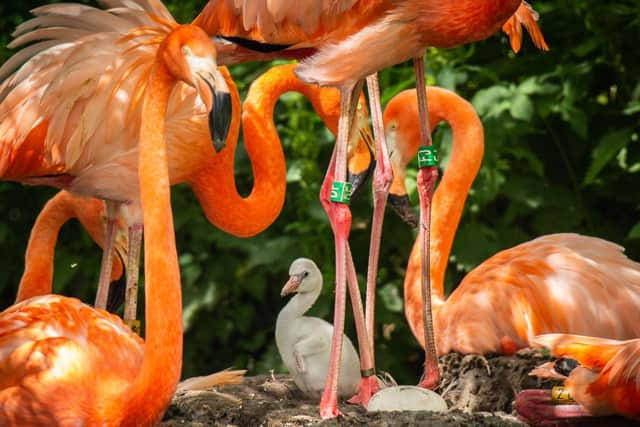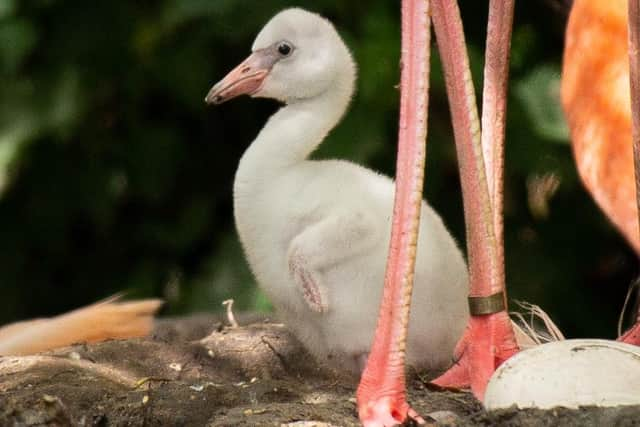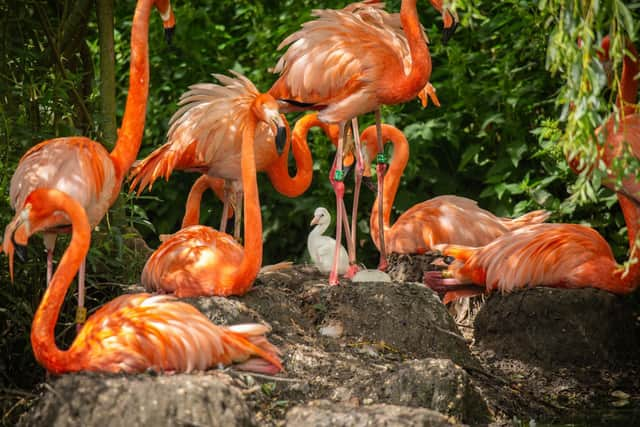Whipsnade Zoo celebrates the arrival of four fluffy flamingo chicks
and live on Freeview channel 276
Zookeepers at ZSL Whipsnade Zoo are celebrating the arrival of four, fluffy flamingo chicks, after the eggs spent a month in an incubator to ensure their survival.
The American flamingo eggs (Phoenicopterus ruber) spent 28 days in an incubator within the conservation Zoo’s special breeding facilities, before being returned to their giant nests, where they have now hatched and met their parents.
Advertisement
Hide AdAdvertisement
Hide AdKeepers at the UK’s largest Zoo found that some of the less experienced parents in the “flamboyance”, (a term for a group of flamingos), weren’t staying on their eggs for the required 28-32 days.


In order to give the chicks the best chance of survival and the adult pairs some practice caring for eggs, the keepers carefully swapped their real eggs for “practice eggs”, placing the real ones in an incubator, until it was almost time for them to hatch.
Matching up numbered eggs to their own map of the nest sites, zookeepers made sure to return each egg to its parents at the nest-site, in perfect time for them to bond with their newly-hatched chicks.
Gary Ward, Curator of Birds at ZSL said: “Flamingos are brilliant parents, working together – usually as a monogamous pair – to care for their eggs and subsequent chicks.
Advertisement
Hide AdAdvertisement
Hide Ad"However, sometimes younger birds haven’t got it all figured out yet, and so we stepped in to give a helping hand.


“Now the chicks are growing and developing in their nests, they are being watched over constantly by alternating parents.
"Both male and female flamingo parents feed their fluffy, grey chicks with bright red “crop milk,” which is made in the linings of their digestive tract, and contains fat, protein and blood cells.
"Incredibly, you can usually spot the new parents in a group, because they give so much of their own pigment to their chicks that they almost turn white!”
Advertisement
Hide AdAdvertisement
Hide AdFlamingos have one of the longest lifespans of any bird in the world, with an average life expectancy of 40 years and with some flamingos having lived up to 70.


Summer visitors to the Zoo can visit the flamingo chicks alongside their prehistoric ancestors, when the Zoo’s Zoorassic Park experience opens, on July 24.
Visitors will be transported to a prehistoric world where they will come face-to-face with immense, moving and roaring dinosaurs, including an 11m tall brachiosaurus and a 12m long tyrannosaurus rex.
Best known for its own colossal beasts that graze enormous enclosures, like the Zoo’s two herds of prehistoric looking rhinoceroses, ZSL Whipsnade Zoo is home to over 10,000 amazing animals, including Amur tigers, spritely squirrel monkeys and adorable otters.
Tickets for ZSL Whipsnade Zoo can be booked here.